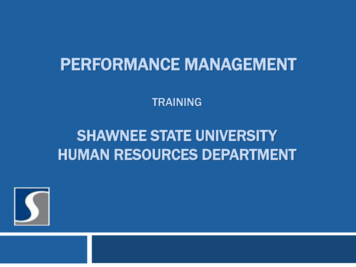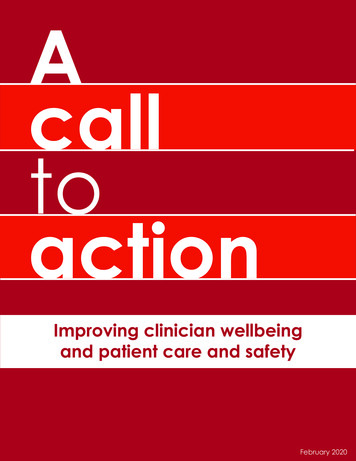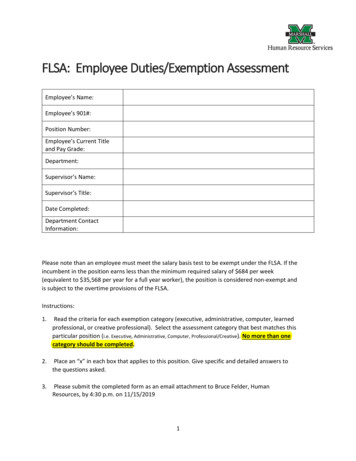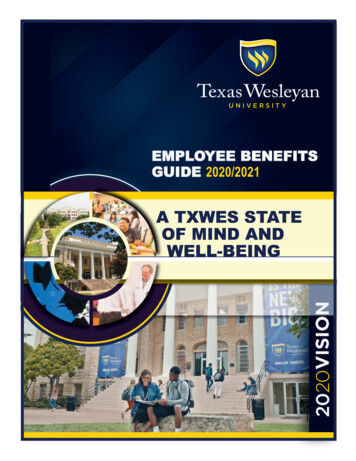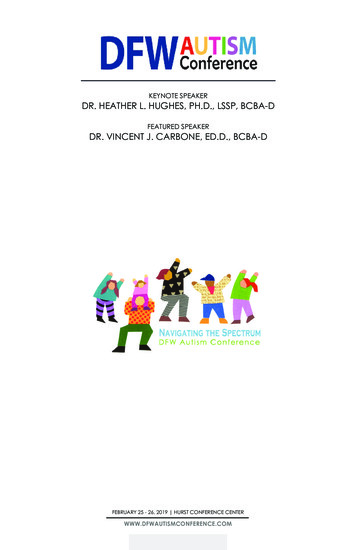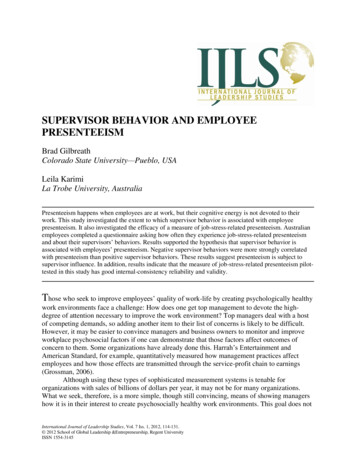
Transcription
SUPERVISOR BEHAVIOR AND EMPLOYEEPRESENTEEISMBrad GilbreathColorado State University—Pueblo, USALeila KarimiLa Trobe University, AustraliaPresenteeism happens when employees are at work, but their cognitive energy is not devoted to theirwork. This study investigated the extent to which supervisor behavior is associated with employeepresenteeism. It also investigated the efficacy of a measure of job-stress-related presenteeism. Australianemployees completed a questionnaire asking how often they experience job-stress-related presenteeismand about their supervisors’ behaviors. Results supported the hypothesis that supervisor behavior isassociated with employees’ presenteeism. Negative supervisor behaviors were more strongly correlatedwith presenteeism than positive supervisor behaviors. These results suggest presenteeism is subject tosupervisor influence. In addition, results indicate that the measure of job-stress-related presenteeism pilottested in this study has good internal-consistency reliability and validity.Those who seek to improve employees’ quality of work-life by creating psychologically healthywork environments face a challenge: How does one get top management to devote the highdegree of attention necessary to improve the work environment? Top managers deal with a hostof competing demands, so adding another item to their list of concerns is likely to be difficult.However, it may be easier to convince managers and business owners to monitor and improveworkplace psychosocial factors if one can demonstrate that those factors affect outcomes ofconcern to them. Some organizations have already done this. Harrah’s Entertainment andAmerican Standard, for example, quantitatively measured how management practices affectemployees and how those effects are transmitted through the service-profit chain to earnings(Grossman, 2006).Although using these types of sophisticated measurement systems is tenable fororganizations with sales of billions of dollars per year, it may not be for many organizations.What we seek, therefore, is a more simple, though still convincing, means of showing managershow it is in their interest to create psychosocially healthy work environments. This goal does notInternational Journal of Leadership Studies, Vol. 7 Iss. 1, 2012, 114-131. 2012 School of Global Leadership &Entrepreneurship, Regent UniversityISSN 1554-3145
Gilbreath & Karimi / INTERNATIONAL JOURNAL OF LEADERSHIP STUDIES115include complicated causal chains and layers of intervening variables. Instead, we would like toshow managers how their own behavior affects employee behavior.Managers get things done mostly not by way of their own efforts, but through the effortsof their employees. For high-level results, managers need employees who are focused andproductive. Mid- and lower-level managers are likely to be particularly affected by employeeswho are not highly focused on their work. Cooper (1994) argued that the costs of suchemployees, come in the form of lack of added value to the product or service rendered, or indeed,even a decrement to performance, in the sense that additional labour or materials arerequired to rectify the poor quality product or service. This is the great hidden cost ofstress at work, that is, of not adequately creating the work environments that lead toenhanced well-being and productivity. (p. 2)We, therefore, set out to identify management-practice outcomes that would be salient tomanagers, but not prohibitively difficult to assess. We wanted variables (a) with evident effectson productivity and on managers themselves; (b) that would not be unduly difficult to measure orwhich are causally ambiguous (such as health-care costs); and (c) that would be easilyunderstood and face valid. The concept of presenteeism fulfills this description.PresenteeismPresenteeism occurs when employees are physically present, but mentally absent. Inother words, employees are at work, but their cognitive energy is not devoted to their work. Insome cases, they will be going through the motions of work while their attention is focusedelsewhere. In other cases, they will not be working at all. So, unlike absenteeism, where theemployee is either present or absent, there will be varying degrees of presenteeism.We were introduced to the construct by Cooper (1994), who defined presenteeism as“ people turning up to work, who are so distressed by their jobs or some aspect of theorganizational climate that they contribute little, if anything, to their work” (p. 2). As defined byCooper, then, presenteeism is a consequence of a negative work environment. This article agreesthat employees suffering from presenteeism are not giving their full attention to their job. Suchemployees are likely to be less productive, make more mistakes, provide lower-quality service,and be less innovative, which has repercussions for the organization and its managers. Managersare judged by their results, and many of these results are achieved through the efforts of rankand-file employees. Many organizations today are downsized and lean, and there are fewer coworkers who can pick up the slack left by presentees.Furthermore, mistakes or “intellectual accidents” (Williams & Cooper, 1999) made bymentally absent employees can be extremely costly. Williams and Cooper related how a machinesetter, “Geoff,” distracted by domestic worries, performed his work on autopilot. Unfortunately,the job he was working on was an initial production run for a new customer for whom Geoff’semployer had spent a great deal of time and money to win business. His supervisor monitoredthe setup, but could not tell that, “although Geoff’s body was doing the work, his mind waselsewhere” (p. 52). The parts produced and shipped did not meet the customer’s needs andcaused a serious loss of production, resulting in a cancellation of further business with the firm.This incident clearly illustrates how managers and organizations have an interest in minimizingpresenteeism.International Journal of Leadership Studies, Vol. 7 Iss. 1, 2012, 114-131. 2012 School of Global Leadership &Entrepreneurship, Regent UniversityISSN 1554-3145
Gilbreath & Karimi / INTERNATIONAL JOURNAL OF LEADERSHIP STUDIES116Presenteeism and Job StressResearch on presenteeism has been predominately related to presenteeism resulting fromhealth problems. In fact, some researchers have defined presenteeism as “the problem of workersbeing on the job but, because of illness or other medical conditions, not fully functioning”(Hemp, 2004, p. 49). We disagree with this narrow view of presenteeism. This would beanalogous to conceptualizing absenteeism as not being on the job because of illness or othermedical conditions when absenteeism can be a result of a variety of different causes. This paperpurports that presenteeism is better conceptualized like absenteeism, or as a phenomenon with anearly limitless number of possible causes. Additionally, more accurate nomenclature forpresenteeism scales should also be implemented. The Stanford Presenteeism Scale, for example,would be more aptly named the Stanford Health-Related Presenteeism Scale. The reason forpointing this out is not to malign worthwhile streams of research. Rather, it is to ensure thatresearchers interested in presenteeism and its effects are clear about what they are attempting tomeasure, which, in this case, is job-stress-related presenteeism. More precise nomenclature (e.g.,“sickness presenteeism”) has emerged in some recent articles (Caverley, Cunningham, &McGregor, 2007; Quick, Macik-Frey, & Cooper 2007).Along with other researchers (Beehr & Schuler, 1978; Dohrenwend, 1978; Mohr & Puck,2007; Motowidlo, Packard, & Manning, 1986; Perlman & Hartman, 1982; Sulsky & Smith,2005), this article conceptualizes stress as the mediator between stressors and strains. In terms ofthe nomological network, what we are referring to as job-stress-related presenteeism is a form ofpsychological strain whose antecedent is job stress. It is predicted that job-stress-relatedpresenteeism will have non-causal negative correlations with outcomes such as job satisfactionand work engagement, and positive correlations with other psychological strains (e.g., burnout).The consequences of presenteeism are hypothesized to be reduced quality and quantity of work.It is expected that work quality will be especially vulnerable because, as illustrated by the Geoffscenario, it is possible for workers to go through the motions of their work while suffering fromstress-related presenteeism.Among related constructs, job-stress-related presenteeism is most closely the opposite ofRothbard’s (2001, p. 656) conceptualization of engagement, which focuses on attention (“thecognitive availability and the amount of time one spends thinking about a role”) and absorption(“the intensity of one’s focus on a role”). This paper, however, does not regard presenteeism asmerely work disengagement or low engagement. Most definitions of engagement (Rothbard;Schaufeli, Salanova, Gonźalez-Roma, & Bakker, 2002) characterize it as pervasive and rolebased, whereas presenteeism is more transitory and situational (event-based).The next section focuses on one potential stressor and our primary independent variable:supervisor behavior. The term supervisor is used because this study is primarily targeting theeffects of an employee’s immediate boss rather than management in general.Supervisor BehaviorIt is known that supervisors can have a significant influence on employees’ morale andtheir work behavior (Fleishman & Harris, 1962; Walker, Guest, & Turner, 1956). Since the1970s, researchers have learned that supervisors affect employees’ psychological well-being(Gavin & Kelley, 1978; Sheridan & Vredenburgh, 1978). These findings continued to cumulatethrough the 1980s and 1990s (Duxbury, Armstrong, Drew, & Henly, 1984; Landeweerd &International Journal of Leadership Studies, Vol. 7 Iss. 1, 2012, 114-131. 2012 School of Global Leadership &Entrepreneurship, Regent UniversityISSN 1554-3145
Gilbreath & Karimi / INTERNATIONAL JOURNAL OF LEADERSHIP STUDIES117Boumans, 1994; Martin & Schinke, 1998; Seltzer & Numerof, 1988). Stout (1984), for example,found that supervisor behavior was related to employees’ health problems and their level ofphysical, emotional, and mental exhaustion.More recently, Karlin, Brondolo, and Schwartz (2003) found that support fromsupervisors was negatively related to systolic blood pressure for employees in high-stressconditions. Similarly, Wager, Fieldman, and Hussey (2003) found that employees’ bloodpressure was higher when they were working under a less-favorably perceived supervisor, andthe measured difference was high enough to make it a potential risk factor for the developmentof coronary heart disease. Karimi (2008) reported that supervisory support has significant effectson employees’ well-being and intrinsic job satisfaction. In similar studies (Karimi & Nouri,2009; Karimi, Karimi, & Nouri, 2011), researchers reported that the degree of perceivedmanagerial/supervisory support in the workplace is associated with the experience of workfamily conflict and employees’ perceived level of well-being. Gilbreath and Benson (2004)found behavior of supervisors to be predictive of employees’ psychological well-being. Theyalso found that supervisors were a more significant influence on well-being than co-workers,friends, and family members.It is apparent that supervisors can be a key influence on what employees experience atwork, and the list of outcomes associated with supervisor behavior continues to grow. Jannsonand Linton (2006) found that employees who perceived their supervisor as supportive were morelikely to recover from insomnia than employees who saw their supervisor as unsupportive. AndHoobler and Brass (2006) found that abusive supervision was associated with familyundermining, suggesting that abused employees unload supervisor-induced aggression after theyget home. Findings like these are less surprising when one considers that, for many employees,the supervisor is the most influential psychosocial factor in one’s workplace (O'Driscoll &Beehr, 1994). Furthermore, supervisors are a particularly accessible leverage point from which toalter the workplace (Bunker & Wijnberg, 1985). Supervisors should play a role in creatinghealthier workplaces because they can eliminate or reduce the effects of some negative workfactors plaguing employees. Even supervisors with limited control over other workplace stressorscan control their own behavior (Stout, 1984).The Supervisor Behavior-Presenteeism LinkDonaldson (2003) noted, “anyone who has ever worked for anyone else will tell you thatone’s manager has an enormous influence on the level of stress in the workplace” (p. 27). It isnot difficult to find further support for Donaldson’s assertion (e.g., Lind & Otte, 1994; Oaklander& Fleishman, 1964; Offermann & Hellmann, 1996). Peterson (1999) found lack of considerationby management to be the major determinant of stress among employees he studied. Also,Gilbreath (2001) found that supervisor behaviors such as ignoring employee suggestions, being aguarded (i.e., not open) communicator, and leaving employees out of the communication loophad particularly strong correlations with employees’ job stress.Supervisors can also have positive effects on employees’ degree of experienced stress.Yarker, Donaldson-Feilder, Lewis, and Flaxman (2007) identified 19 clusters of supervisorbehaviors reported to be helpful in managing employees’ pressure and stress, includingmanaging workload and resources, dealing with work problems, increasing accessibility andvisibility, and taking responsibility. Gilbreath (2001) found behaviors such as planning work tomanage its demands, balancing workloads equitably, and trying to see employees’ sides ofInternational Journal of Leadership Studies, Vol. 7 Iss. 1, 2012, 114-131. 2012 School of Global Leadership &Entrepreneurship, Regent UniversityISSN 1554-3145
Gilbreath & Karimi / INTERNATIONAL JOURNAL OF LEADERSHIP STUDIES118situations to have especially strong negative correlations with employees’ job stress. Therefore,ceteris paribus, employees working for a supervisor who treats them well will experience lessstress and presumably less presenteeism than employees working for one who treats them poorly.Thus, the first general hypothesis for this study is:H1:Both negative and positive supervisor behavior will be associated withemployees’ job-stress-related presenteeism.Although both positive and negative supervisor behavior may influence the degree towhich employees experience presenteeism, we wondered which would have a greater influence.A review of theory and literature related to that question revealed Taylor’s (1991) mobilizationperspective, which suggests that negative events receive a disproportionate amount of cognitiveattention. This perspective conforms to our experience as researchers of managerial behavior.We have collected hundreds of critical incidents of managerial behavior from employees at manydifferent work sites. Although we have asked for both positive and negative incidents, we havefound that negative incidents outnumber positive incidents by roughly a 3-to-1 margin.Taylor’s (1991) work indicated that negative events “elicit more physiological, affective,cognitive, and behavioral activity than neutral or positive events” (p. 67). As Newsom,Nishishiba, Morgan, and Rook (2003) stated, “negative information or events have adaptivesignificance and lead to greater physiological arousal, trigger more cognitive processing, and areascribed greater importance” (p. 752). This could be a result of natural selection, which mayhave led us to have stronger reactions to negative stimuli than to positive stimuli (Cacioppo,Gardner, & Berntson, 1997). Some researchers believe that negative stimuli attract attentionthrough an automatic vigilance mechanism and that, once attended, have stronger effects thanpositive stimuli (Ito, Larsen, Smith, & Cacioppo, 1998). This is supported by the work ofNewsom et al., who concluded that negative social interactions have longer-lasting effects thanpositive social interactions. In addition, in their study on employee burnout and its relationshipwith leadership styles, Hetland, Sandal, and Johnsen (2007) found that perceptions of negativeleadership behaviors are more important for burnout than perceptions of positive leadershipbehaviors.Based on Taylor’s (1991) mobilization perspective and the related body of previousresearch, it is also predicted:H2:Negative supervisor behavior will have stronger associations with job-stressrelated presenteeism than positive supervisor behavior.MethodParticipants and ProcedureData were collected from Australian employees in two hospitals. This was a“convenience sample” in the sense that we contacted these organizations and they permittedaccess to their employees. Packets containing an introduction to the study, an invitation toparticipate, and a questionnaire were mailed to 400 employees. An email reminder was also sentto potential participants. A total of 180 responses were received, yielding a response rate of 45%.A review of data revealed that 31 questionnaires were unusable because of incompleteness,International Journal of Leadership Studies, Vol. 7 Iss. 1, 2012, 114-131. 2012 School of Global Leadership &Entrepreneurship, Regent UniversityISSN 1554-3145
Gilbreath & Karimi / INTERNATIONAL JOURNAL OF LEADERSHIP STUDIES119resulting in a final dataset based on the responses of 149 employees. The resulting sample was59% male with a median age of 31. Eleven percent of respondents were inmanagerial/supervisory positions, 18% were in manual positions, and 71% were in non-manual(e.g. administrative, technical, sales) positions. Among these, 46% were working part-time and54% were full-time employees.MeasuresThe data were collected via a paper-and-pencil questionnaire. Except for demographicsand controls, all variables were measured using Likert-type response formats.Demographic and control variables. Data were collected on each respondents’ age,type of work (part-time or full-time status), and hours worked per week.Supervisor behavior. Supervisor behavior was measured with the Supervisor PracticesInstrument (SPI), which was created to study the effects of supervisor behavior on employeewell-being (National Institute for Occupational Safety and Health, n.d.). It is a conglomerativemeasure of positive and negative supervisor behaviors from which composite scores arecalculated (Gilbreath, 2005). Higher scores on the SPI indicate that, according to employeerespondents, their supervisor engages more frequently in positive behaviors and less often innegative behaviors. The response anchors range from all the time (5) to never (1). Scores on theSPI have been found to be predictive of employee psychiatric disturbance (Gilbreath & Benson,2004).The SPI was chosen because the primary interest of this study is the overall effect ofsupervisor behavior on employees’ stress-related presenteeism, not in narrow sub-types ofsupervisor behavior (e.g., initiation of structure, supervisor support). In other words, this study isinvestigating the extent to which how someone supervises employees affects the employees’degree of presenteeism rather than in associations between specific factors of supervisorbehavior and presenteeism. The aim of this study, therefore, is more closely aligned with aquestion such as, “does whether someone is perceived by employees to be a good or bad bossaffect employees’ presenteeism?” than it is with a question such as, “does transactional ortransformational leadership show stronger associations with presenteeism?” The SPI’s 63 itemsencompass a wide variety of supervisor behaviors, including those related to job control (e.g., “Isflexible about how I accomplish my objectives”); leadership (e.g., “Makes me feel like part ofsomething useful, significant, and valuable”); communication (e.g., “Encourages employees toask questions”); consideration (e.g., “Shows appreciation for a job well done”); social support(e.g., “Steps in when employees need help or support”); group maintenance (e.g., “Fails toproperly monitor and manage group dynamics”); organizing (e.g., “Plans work to level out theload, reduce peaks and bottlenecks”); and looking out for employee well-being (e.g., “Strikes theproper balance between productivity and employee well-being”) (Gilbreath & Benson, 2004).In addition to the breadth of behaviors it encompasses, using the SPI enabled us to createmeasures of positive supervisor behavior and negative supervisor behavior. The measure ofpositive supervisor behavior is comprised of the SPI’s 52 positive behaviors. Example itemsinclude: “Shields employees from unnecessary interference so they can perform their jobseffectively and productively”; “Balances the workload among employees equitably”; and“Admits when he/she is wrong or makes a mistake.” The variable positive supervisor behaviorwas created by calculating the mean score on the 52 items. Likewise, the measure of negativesupervisor behavior is comprised of the SPI’s 11 negative behaviors. Example items include:International Journal of Leadership Studies, Vol. 7 Iss. 1, 2012, 114-131. 2012 School of Global Leadership &Entrepreneurship, Regent UniversityISSN 1554-3145
Gilbreath & Karimi / INTERNATIONAL JOURNAL OF LEADERSHIP STUDIES120“Ignores employee suggestions”; “Tends to be guarded (e.g., not open) in his/hercommunication”; and “Remains aloof from employees.” The variable negative supervisorbehavior was created by calculating the mean score on the 11 items.Job stress. Job-related stress was measured with two items created by Motowidlo,Packard, and Manning (1986) to assess the stress employees experience because of their job: “Ihave felt a great deal of stress because of my job”; and “My job has been extremely stressful.”The scale anchors were strongly disagree (5) and strongly agree (1). For final analysis, the scaleanchors were reversed to be consistent with other study variables. Thus, higher scores on thisscale suggest higher levels of job stress.Job-stress-related presenteeism. As noted earlier, the working definition ofpresenteeism for this study is when employees are physically present, but mentally absent. Jobstress-related presenteeism occurs when employees are at work, but, because of job stress, only aportion of their cognitive energy is devoted to their work. To measure job-stress-relatedpresenteeism, a self-report scale created by Gilbreath and Frew (2008) was used. This study isthe first applied use of that scale, which was created to fill the need for a measure of job-stressrelated presenteeism. The scale anchors are all the time (5) and never (1). It asks employees torespond to six items: “I’m unable to concentrate on my job because of work-related stress”; “Ispend a significant proportion of my workday coping with work stress”; “work stress distractsmy attention away from my job tasks”; “mental energy I’d otherwise devote to my work issquandered on work stressors”; “I delay starting on new projects at work because of stress”; and“I spend time talking to co-workers about stressful work situations.”ResultsInternal-consistency reliability for most measures was good. The Cronbach’s alpha forthe measure of negative supervisor behavior was .92, .98 for positive supervisor behavior, and.91 for job-stress-related presenteeism. Internal-consistency reliability for the measure of jobstress was acceptable (α .80).To test the discriminant validity of the positive and negative dimensions of supervisorbehavior, a confirmatory factor analysis was performed with the entire sample. Since there arecomputational limitations for a structural equation analysis involving too many indicators, threeitem parcels were used for each construct to reduce the number of indicators, consistent withother researchers (Hui, Law, & Chen, 1999; Ilies, Scott, & Judge, 2006). Specifically, the itemswith the highest and the lowest loading were combined by averaging them until three aggregateditems were yielded. Model fit was evaluated using the chi-square statistic, the chi-square todegrees of freedom ratio, the goodness-of-fit index, the comparative fit index (CFI), the TuckerLewis index, and the root-mean square error of approximation. The one-factor model (nodimension of supervisor behavior) was compared with the two-factor model (positive andnegative supervisor behavior). The results suggest an adequate fit to the data. As shown in Table1, the chi-square statistic and associated fit indices showed a substantial improvement for thetwo-factor model (χ2 18.58, robust CFI 0.99) compared to one factor model (χ2 486.50,robust CFI 0.54), suggesting the validity of the two-factor model of supervisor behavior.Means, standard deviations, and intercorrelations for all study variables are presented inTable 2. As indicated, employees’ presenteeism was significantly correlated with age, job stress,and negative and positive supervisor behavior (p .01).International Journal of Leadership Studies, Vol. 7 Iss. 1, 2012, 114-131. 2012 School of Global Leadership &Entrepreneurship, Regent UniversityISSN 1554-3145
Gilbreath & Karimi / INTERNATIONAL JOURNAL OF LEADERSHIP STUDIES121Table 1Confirmatory Factor Analysis of the Two-Factor Model of Supervisor BehaviorModelsχ2dfCFIOne-factor model (one dimension)486.5090.54Two-factor model (positive-negative supervisor behavior)18.5880.99Table 2Pearson Inter-Correlation among All Variables (N 149)MeanSD31.17.5----3. Working hours38.05.834. Presenteeism1.440.815. Job stress1.640.951.510.692.300.661. Age2. Work type (fulltime/part-time)6. Negative supervisorBehavior7. Positive supervisorBehavior12345670.330.33-0.23 0.160.530.57-0.360.34-0.35-0.53Recall the first hypothesis that both negative and positive supervisor behavior would beassociated with employees’ job-stress-related presenteeism. This hypothesis is supported by thestatistically significant correlations between presenteeism and positive and negative supervisorbehavior. Further analysis, using hierarchical regression, was conducted to investigate the levelof association of each dimension of supervisor behavior with presenteeism. As shown in Table 3,Step 1 of the hierarchical regression analysis required controlling for the effects of demographicvariables that often are associated with employees’ reactions to work: age, part- or full-timeemployment, and hours worked per week. Then, Step 2 involved entering the negative supervisorbehavior variable to test its ability to make an incremental contribution to the prediction ofpresenteeism beyond that made by the control variables. The results show that negativesupervisor behavior made a statistically significant contribution to the prediction of presenteeismscores (β 0.50) beyond the Step 1 variate, comprised of age, part- or full-time employment(“work type”), and hours worked per week (i.e., “working hours”).International Journal of Leadership Studies, Vol. 7 Iss. 1, 2012, 114-131. 2012 School of Global Leadership &Entrepreneurship, Regent UniversityISSN 1554-3145
Gilbreath & Karimi / INTERNATIONAL JOURNAL OF LEADERSHIP STUDIES122Table 3Hierarchical Regression Analysis with Presenteeism, Demographic, & Negative SupervisorBehavior Variables (N 149)VariablesStep 1βStep 2ΒAge-0.23**-0.20*Work type-0.15-0.05Working hours0.02.003Negative supervisor behavior0.50***R0.300.56 R20.090.32F3.56**12.52***Note: *** p .001; ** p .01; * p .05.Similar results were found for positive supervisor behavior. As reported at Table 4,positive supervisor behavior made significant contribution to the prediction of presenteeism (β -0.33).Table 4Hierarchical Regression Analysis with Presenteeism, Demographic & Positive SupervisorBehavior Variables (N 149)VariablesStep 1ΒStep 2ΒAge-0.23*-0.18Work type-0.16-0.17Working hours0.030.07Positive supervisor behavior-0.33**R0.310.45 R20.090.20F3.88*6.98**Note: ** p .01; * p .05.International Journal of Leadership Studies, Vol. 7 Iss. 1, 2012, 114-131. 2012 School of Global Leadership &Entrepreneurship, Regent UniversityISSN 1554-3145
Gilbreath & Karimi / INTERNATIONAL JOURNAL OF LEADERSHIP STUDIES123The correlations in Table 2 provide some indication of the veracity of the secondhypothesis—that negative supervisor behavior would have stronger associations with job-stressrelated presenteeism than positive supervisor behavior. The absolute value of the correlationbetween positive supervisor behavior and presenteeism (-.36) is much smaller than that fornegative supervisor behavior (.57). Hierarchical regression analysis was used to conduct anadditional test of the difference in degree of association. Control variables (age, part- or full-timeemployment, and hours worked per week) were entered in Step 1, positive supervisor behavior inStep 2, and negative supervisor behavior in Step 3. As shown in Table 5, although positivesupervisor behavior was significant at Step 2 of the analysis (β -0.36, p .01), it did not makea statistically significant contribution to the prediction of presenteeism beyond negativesupervisor behavior (Step 3 of the analysis) (β -0.08, p .01). This supports the hypothesis thatnegative supervisor behavior will have stronger associations on job-stress-related presenteeismthan positive supervisor behavior.Table 5Hierarchical Regression Analysis with Presenteeism, Demographic & Supervisor BehaviorVariables (N 149)VariablesStep 1Step 2Step 3Age-0.23-0.17-0.18**Work type-0.15-0.16-0.06Working hours0.020.050.01-0.36**-0.08Positive supervisor behaviorNegative supervisor 7.03***16.77***2Note: The coefficients are standardized beta weights. *** p .001; ** p .01; *
It is apparent that supervisors can be a key influence on what employees experience at work, and the list of outcomes associated with supervisor behavior continues to grow. Jannson and Linton (2006) found that employees who perceived their supervisor as supportive were more likely to recover from insomnia than employees who saw their supervisor .
